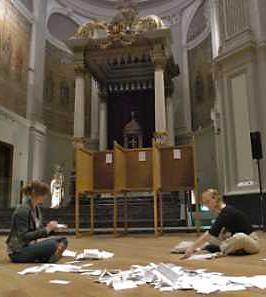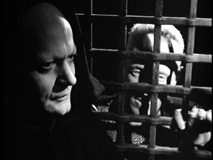* Update of 8 PM Nov. 19:
The title refers to a work by Beckett.
"There is nothing outside itself that Quad
might be about." — Sue Wilson.
The Klein group is not so limited.
Tuesday, November 19, 2013
Tuesday, June 27, 2006
Tuesday June 27, 2006
Revisited
In memory of
Irving Kaplansky,
who died on
Sunday, June 25, 2006
“Only by the form, the pattern,
Can words or music reach
The stillness, as a Chinese jar still
Moves perpetually in its stillness.”
— T. S. Eliot
Kaplansky received his doctorate in mathematics at Harvard in 1941 as the first Ph.D. student of Saunders Mac Lane.
From the April 25, 2005, Harvard Crimson:
Ex-Math Prof Mac Lane, 95, Dies
Gade University Professor of Mathematics Barry Mazur, a friend of the late Mac Lane, recalled that [a Mac Lane paper of 1945] had at first been rejected from a lower-caliber mathematical journal because the editor thought that it was “more devoid of content” than any other he had read.“Saunders wrote back and said, ‘That’s the point,'” Mazur said. “And in some ways that’s the genius of it. It’s the barest, most Beckett-like vocabulary that incorporates the theory and nothing else.”
He likened it to a sparse grammar of nouns and verbs and a limited vocabulary that is presented “in such a deft way that it will help you understand any language you wish to understand and any language will fit into it.”
A sparse grammar of lines from Charles Sanders Peirce (Harvard College, class of 1859):
Related entry: Binary Geometry.
Thursday, June 2, 2005
Thursday June 2, 2005
at the Altar of Facts
From Log24,
April 28, 2005:
(See also Log24,
April 5, 2005.)
Compare this diagram with that of
Samuel Beckett in Quad (1981):

Related quotation:
Barry Mazur on a seminal paper of algebraist Saunders Mac Lane:
The paper was rejected “because the editor thought that it was ‘more devoid of content’ than any other he had read. ‘Saunders wrote back and said, “That’s the point,”‘ Mazur said. ‘And in some ways that’s the genius of it. It’s the barest, most Beckett-like vocabulary that incorporates the theory and nothing else.'”

Prime Minister of France:
“M. de Villepin positively worships Napoleon, and models himself after his hero. In a 600-page biography, Villepin wrote admiringly about the difference between great men like Napoleon and the ‘common run’ of men. It is worth reading every word carefully.
‘Here we touch on that particular essence of great men, on what distinguishes Napoleon or Alexander, Caesar or de Gaulle, from the common run. It is excess, exaltation, and a taste for risk that forms their genius. It is why they are often better understood in their élan by writers and poets, who are possessed of the same thirst for the absolute, than by those who pray at the altar of facts.’
(New Republic)
And in praise of French nationalism, de Villepin wrote,
‘The Gaullist adventure renewed the élan of [Napoleon’s] Consulate through the restoration of a strong executive and the authority of the State, the same scorn for political parties and for compromise, a common taste for action, and an obsession with the general interest and the grandeur of France.’
Those words come straight from 1800. Napoleon’s ‘genius,’ his ‘thirst for the absolute,’ ‘excess, exaltation, and a taste for risk,’ ‘a strong executive and the authority of the State,’ ‘his ‘scorn for political parties and for compromise,’ and ‘an obsession with the grandeur of France’ — it is all classic national hero worship. But today that kind of thinking is used to promote a new vision of destiny, the European Union.”
Sunday, May 1, 2005
Sunday May 1, 2005
Harvard's Barry Mazur on
one mathematical style:
"It’s the barest, most Beckett-like vocabulary
that incorporates the theory and nothing else."
Samuel Beckett, Quad (1981):

A Jungian on this six-line logo:
"They are the same six lines
that exist in the I Ching….
Now observe the square more closely:
four of the lines are of equal length,
the other two are longer….
For this reason symmetry
cannot be statically produced
and a dance results."
— Marie-Louise von Franz,
Number and Time (1970),
Northwestern U. Press
paperback, 1979, p. 108
A related logo from
Columbia University's
Department of Art History
and Archaeology:

Also from that department:

Meyer Schapiro Professor
of Modern Art and Theory:
"There is no painter in the West
who can be unaware of
the symbolic power
of the cruciform shape
and the Pandora's box
of spiritual reference
that is opened
once one uses it."
"In the garden of Adding
live Even and Odd…"
— The Midrash Jazz Quartet in
City of God, by E. L. Doctorow
THE GREEK CROSS
are the same length.
Here, for reference, is a Greek cross
within a nine-square grid:

Related religious meditation for
Doctorow's "Garden of Adding"…
Types of Greek cross
illustrated in Wikipedia
under "cross":

THE BAPTISMAL CROSS

a Greek cross, which is superimposed
on a Greek 'chi,' the first letter
of the Greek word for 'Christ.'
Since the number eight is symbolic
of rebirth or regeneration,
this cross is often used
as a baptismal cross.
Related material:

Fritz Leiber's "spider"
or "double cross" logo.
See Why Me? and
A Shot at Redemption.
Happy Orthodox Easter.
Thursday, April 28, 2005
Thursday April 28, 2005
Black Moses
For an explanation of the title, see
the previous entry and
Robert P. Moses and The Algebra Project.
For another algebra project, see
Log24 entries of April 14-25 as well as
the following “X in a box” figure
from March 10, 2005 and
April 5, 2005.
Those interested in artistic rather than mathematical figures may compare this diagram with that of Samuel Beckett in Quad (1981):

Related quotations:
Barry Mazur on a seminal paper of algebraist Saunders Mac Lane:
The paper was rejected “because the editor thought that it was ‘more devoid of content’ than any other he had read. ‘Saunders wrote back and said, “That’s the point,”‘ Mazur said. ‘And in some ways that’s the genius of it. It’s the barest, most Beckett-like vocabulary that incorporates the theory and nothing else.'”
“There are some ideas you simply could not think without a vocabulary to think them.”
Amen.
Monday, April 25, 2005
Monday April 25, 2005
Mathematical Style:
Mac Lane Memorial, Part Trois
(See also Part I and Part II.)
“We have seen that there are many diverse styles that lead to success in mathematics. Choose one mathematician… from the ones we studied whose ‘mathematical style’ you find most rewarding for you…. Identify the mathematician and describe his or her mathematical style.”
| — Sarah J. Greenwald, take-home exam from Introduction to Mathematics at Appalachian State U., Boone, North Carolina |
From today’s Harvard Crimson:
Ex-Math Prof Mac Lane, 95, Dies
[Saunders] Mac Lane was most famous for the ground-breaking paper he co-wrote with Samuel Eilenberg of Columbia in 1945 which introduced category theory, a framework to show how mathematical structures relate to each other. This branch of algebra has since influenced most mathematical fields and also has functions in philosophy and linguistics, but was first dismissed by many practical mathematicians as too abstract to be useful.
Gade University Professor of Mathematics Barry Mazur, a friend of the late Mac Lane, recalled that the paper had at first been rejected from a lower-caliber mathematical journal because the editor thought that it was “more devoid of content” than any other he had read.
“Saunders wrote back and said, ‘That’s the point,'” Mazur said. “And in some ways that’s the genius of it. It’s the barest, most Beckett-like vocabulary that incorporates the theory and nothing else.”
He likened it to a sparse grammar of nouns and verbs and a limited vocabulary that is presented “in such a deft way that it will help you understand any language you wish to understand and any language will fit into it.”
Also from Appalachian State University
(with illustration by Ingmar Bergman):
“In my hour of weakness,that old enemy
tries to steal my soul.
But when he comes
like a flood to surround me
My God will step in
and a standard he’ll raise.”








